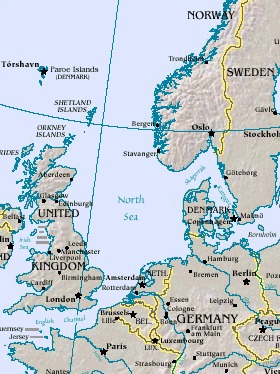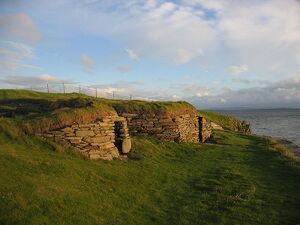Knap of Howar

Knap of Howar on the island of Papa Westray in Orkney, Scotland is a Neolithic farmstead which may be the oldest preserved stone house in northern Europe.[1] Radiocarbon dating shows that it was occupied from 3700 BC to 2800 BC, earlier than the similar houses in the settlement at Skara Brae on the Orkney Mainland.[2]
Location
The site

The farmstead consists of two adjacent rounded rectangular thick-walled buildings with very low doorways facing the sea. The larger and older structure is linked by a low passageway to the other building, which has been interpreted as a workshop or a second house. They were constructed on an earlier midden, and were surrounded by midden material which has protected them. There are no windows; the structures were presumably lit by fire, with a hole in the roof to let out smoke. Though they now stand close to the shore, they would have originally lain inland. The shore shows how the local stone splits into thin slabs, giving a ready source of construction material.
The walls still stand to an eaves height of 1.6 metres (5 ft 3 in), and the stone furniture is intact giving a vivid impression of life in the house. Fireplaces, partition screens, beds and storage shelves are almost intact, and post holes were found indicating the roof structure.
Evidence from the middens shows that the inhabitants were keeping cattle, sheep and pigs, cultivating barley and wheat and gathering shellfish as well as fishing for species which have to be line caught using boats.
Finds of finely-made and decorated Unstan ware pottery link the inhabitants to chambered cairn tombs nearby and to sites far afield including Balbridie and Eilean Domhnuill. The name Howar is believed to be derived from Old Norse word haugr meaning mounds or barrows. The site is in the care of Historic Scotland.[3]
History
What the finds at Knap of Howar signified for British and Orcadian prehistory was something simple, a very early example of houses built by farmers. The arrival of this new way of life in Britain (farming) is poorly understood and matter of much speculation. But DNA analysis can explain where these people came from. As the population grew after 8500 BC in the Near East in the Fertile Crescent people moved towards Europe in search of new lands and brought farming techniques with them. [4]
Alistair Moffat[5] writes that ...In this era of migrations Orkney may not have been fought over. Before the early farmers arrived in the period before Knap of Howar was built in c3600 BC, the archipelago was probably not inhabited. Only one tiny scrap of evidence for occupation before that date has ever been found: a charred hazelnut shell at Tankerness was carbon dated to c6000 BC. And that may have been the deposit of a summer expedition from the mainland of Scotland.
If Orkney was empty, green and fertile Arcadia, that may have encouraged the precocious culture that built the temples at Ness of Brodgar and the monument around them. Other Innovations flowed South. Too heavy and fragile for the mobile Life style of the hunter-gatherers, pottery, the first man-made product in Britain, who needed by sedentary farming Communities for storage.
But it is very difficult to identify the DNA of this remarkable Society. Modern Orkney is not populated by a high percentage of men who carry G lineage – infact they are rarer than in mainland Britain. Instead, another marker from a much later period seems to have largely supplanted the DNA of their farmers. Scandinavians, the Vikings, began raiding at the end of the 8th century AD and when they settled Orkney, they seem to have carried out a similarly brutal removal of the natives as happened across the rest of Britain c4000 BC.
Related sites in Orkney
A comparable, though smaller, site exists at Rinyo on Rousay. Unusually, no Maeshowe-type tombs have been found on Rousay and although there are a large number of Orkney–Cromarty chambered cairns, these were built by Unstan ware people.
Knap of Howar, on the Orkney island of Papa Westray, is a well-preserved Neolithic farmstead. Dating from 3500 BC to 3100 BC, it is similar in design to Skara Brae, but from an earlier period, and it is thought to be the oldest preserved standing building in northern Europe.[6]
There is also a site currently under excavation at Links of Noltland on Westray that appears to have similarities to Skara Brae.[7]
External links
References
- ↑ "Knap of Howar" Historic Scotland.
- ↑ Wickham-Jones, Caroline (2007) Orkney: A Historical Guide. Edinburgh. Birlinn. p. 40.
- ↑ Broch of Burrian Archaeology (The Papar Project)
- ↑ Alistair Moffat: The British: A Genetic Journey, Birlinn, 2013,ISBN:9781780270753, p.78-80
- ↑ Alistair Moffat: The British: A Genetic Journey, Birlinn, 2013,ISBN:9781780270753, p.89-90
- ↑ "The Knap o' Howar, Papay". Orkneyjar.
- ↑ Darvill, Timothy (1987). Prehistoric Britain. London: Yale University Press. ISBN 0-300-03951-4.p. 105

